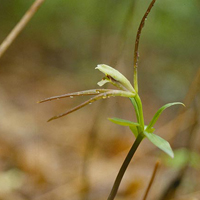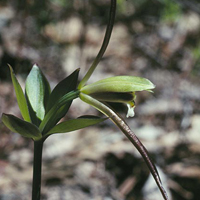Large whorled pogonia
Scientific name: Isotria verticillata


Cover photos credit: Loyal A. Mehrhoff (all photos)
Status
Endangered
“Endangered” means the species lives in the wild in Ontario but is facing imminent extinction or extirpation.
Date added to the Species at Risk in Ontario List
The Large whorled pogonia was already assessed as endangered when the Endangered Species Act took effect in 2008.
Read the Assessment Report
What it looks like
Large Whorled Pogonia is a member of the orchid family. This small and inconspicuous plant reaches about 30 centimetres in height.
Large Whorled Pogonia flowers from late May to early June, producing a single yellowish-green flower just above a whorl of five to six leaves. The flower is mildly fragrant and is pollinated mainly by bees. The seeds require the presence of specific fungi to germinate.
Where it lives
In Ontario, Large Whorled Pogonia has been found in deciduous or mixed forests with sandy soil and a thick layer of leaf litter.
A relatively open forest canopy is required so that enough light can reach the plant.
Where it’s been found in Ontario
Large Whorled Pogonia ranges from New England and Michigan south to Texas and Georgia.
In Canada, there are three records in southwestern Ontario.
The last recorded sighting of Large Whorled Pogonia in Ontario was in 1996, when a single plant was found.
View a Larger version of this map (PDF)
What threatens it
Excessive shade, invasive species such as exotic earthworms and Garlic Mustard, changes in water levels such as flooding, soil compaction, trampling and loss of the soil fungi depend on for survival, are all likely contributors to the decline or loss of this species at sites in Ontario.
Action we are taking
Endangered Species and their general habitat are automatically protected
Recovery strategy
A recovery strategy advises the ministry on ways to ensure healthy numbers of the species return to Ontario.
Read the executive summary (June 15, 2012)
Read the recovery strategy (June 15, 2012)
Government response statement
A government response statement outlines the actions the government intends to take or support to help recover the species.
Read the government response statement (May 31, 2013)
Five-year review of progress
A five-year review of progress made toward protecting and recovering a species is required no later than five years after the government response statement for that species is published.
Read the report on progress towards the protection and recovery of 17 species at risk, including the Large Whorled Pogonia (2018).
Habitat protection
General Habitat Protection - June 30, 2008
What you can do
Report a sighting
Report a sighting of an endangered animal or plant to the Natural Heritage Information Centre. Photographs with specific locations or mapping coordinates are always helpful.
Volunteer
Volunteer with your local nature club or provincial park to participate in surveys or stewardship work focused on species at risk.
Be a good steward
- private land owners have a very important role to play in species recovery; if you find Large whorled pogonia on your land, you may be eligible for stewardship programs that support the protection and recovery of species at risk and their habitats
- invasive species seriously threaten many of Ontario’s species at risk; to learn what you can do to help reduce the threat of invasive species, visit:
www.ontario.ca/invasivespecies
www.invadingspecies.com
www.ontarioinvasiveplants.ca - pollinators, such as bees, are in steep decline across the globe and they play a key role in the survival of many of Ontario’s rare plants; for information on how you can help scientists monitor pollinator populations in Ontario visit:
www.seeds.ca/proj/poll - the Carolinian forests of southern Ontario support an amazing diversity of plants and wildlife, including many species at risk; Carolinian Canada is working to help recover species at risk and their habitats. For more information, visit:
www. www.carolinian.org/SpeciesHabitats.htm.
Report illegal activity
Report any illegal activity related to plants and wildlife to
Quick facts
- as do all orchids, Large Whorled Pogonia has a symbiotic relationship with fungus found in the soil, which means they are interdependent for nourishment and survival; the Large Whorled Pogonia will only produce seeds if the necessary fungus is present in the soil
- the seeds of Large Whorled Pogonia are dispersed by the wind
- orchids can remain dormant in the soil before emerging when the conditions are suitable
